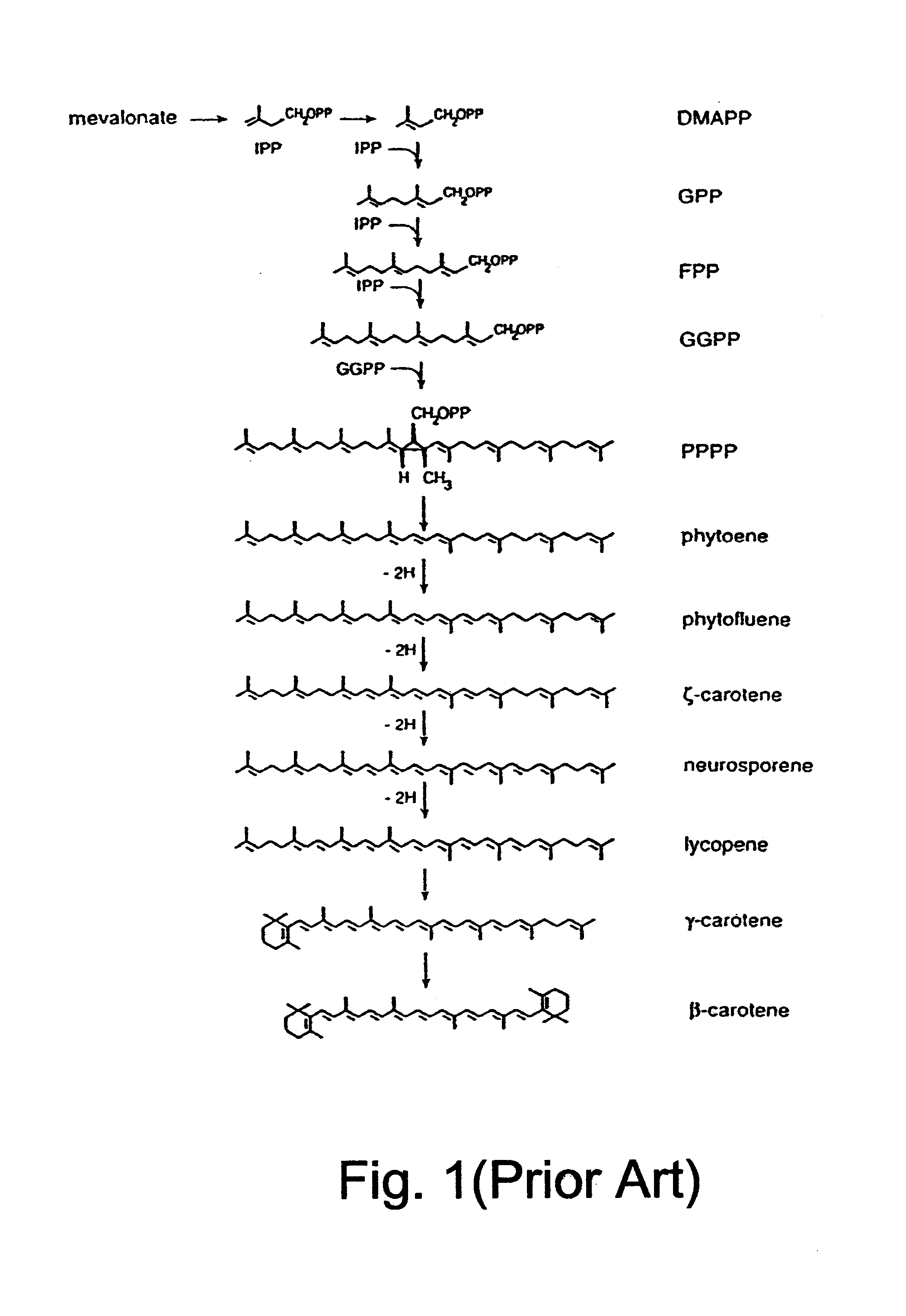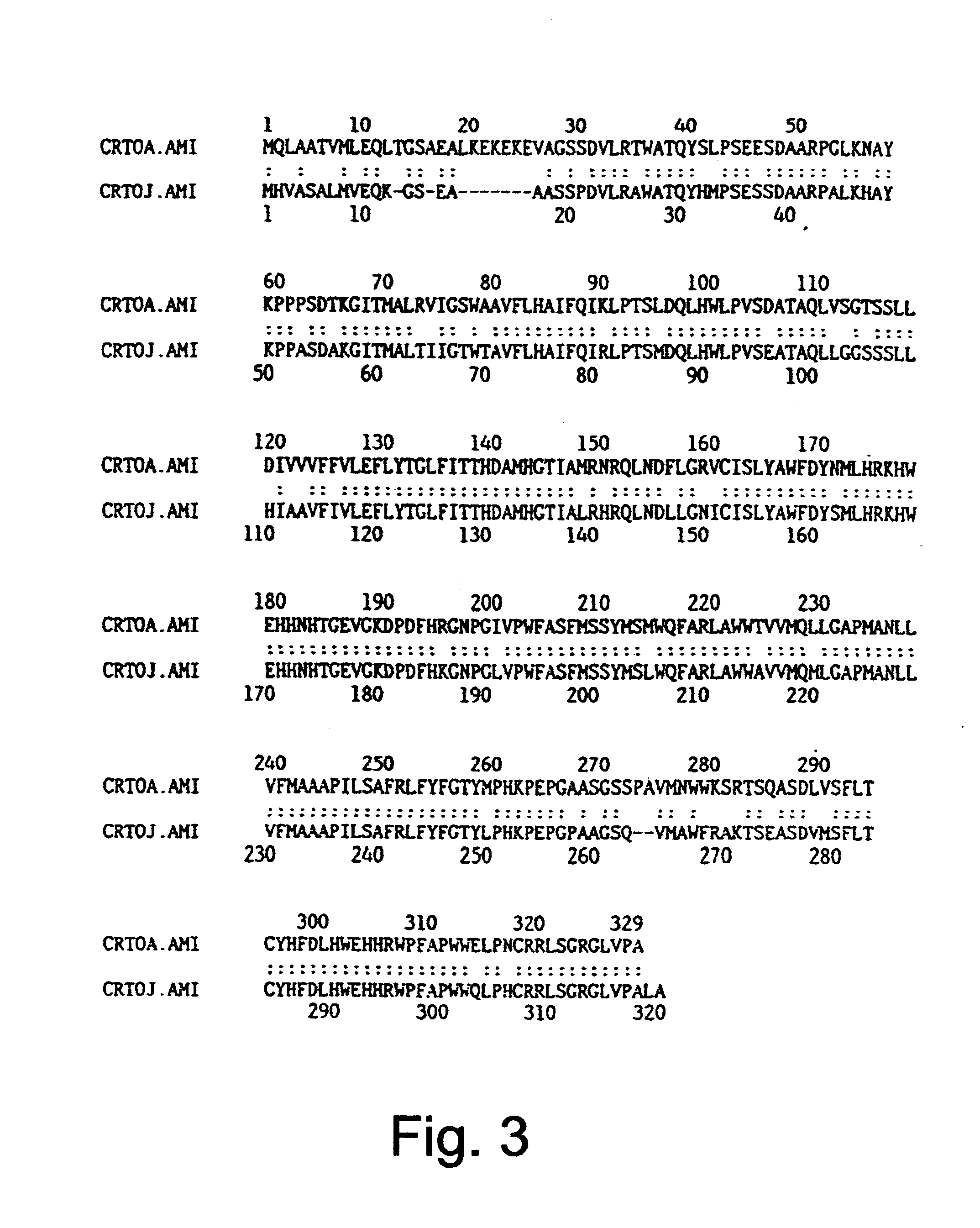Polynucleotide molecule from Haematococcus pluvialis encoding a polypeptide having a beta-C-4-oxygenase activity for biotechnological production of (3S, 3'S) astaxanthin and its specific expression in chromoplasts of higher plants
a technology of haematococcus and polypeptide, which is applied in the field of polypeptide molecule from haematococcus pluvialis, can solve the problems of inability to synthesize carotenoid, inability to use heterologous molecular probes to clone the corresponding genes of cyanobacteria or plants, and inability to fully incubate carotenoid biosynthesis
- Summary
- Abstract
- Description
- Claims
- Application Information
AI Technical Summary
Problems solved by technology
Method used
Image
Examples
example 1
Cloning the .beta.-C-4-oxygenase Gene
A cDNA library was constructed in Lambda ZAP II vector from poly-An RNA of Haematococcus pluvialis cells that had been induced to synthesize astaxanthin by nitrogen deprivation as described hereinabove. The entire library was excised into .beta.-carotene-accumulating cells of Escherichia coli, strain SOLR, which carried plasmid pBCAR (shown in FIG. 4). Screening for a .beta.-carotene oxygenase gene was based on color visualization of colonies of size of 3 mm in diameter. Astaxanthin and other oxygenated forms of .beta.-carotene (i.e., xanthophylls) have distinct darker colors and thus can be detected from the yellow .beta.-carotene background. The screening included approximately 100,000 colonies which were grown on LB medium plates containing ampicillin and chloramphenicol that selected for both the Lambda ZAP II vector in its plasmid propagating form and the pBCAR plasmid. Several colonies showed different color tones but only one exhibited a c...
example 2
Analysis of the .beta.-C-4-oxygenase Activity in Escherichia coli
The red-brown colony presumed to contain a xanthophyll biosynthesis gene (see Example 1 above) was streaked and further analyzed. First, the recombinant ZAP II plasmid carrying the cDNA clone that was responsible for xanthophyll synthesis in Escherichia coli was isolated by preparing plasmid DNA from the red-brown colony, transfecting it to Escherichia coli cells of the strain XL1-Blue and selection on ampicillin-containing medium. This plasmid, designated pHPK (pHPK is a Lambda ZAP II vector containing an insert isolated from the red-brown colony), was used to transform .beta.-carotene-producing Escherichia coli cells (Escherichia coli SOLR strain that carry the plasmid pBCAR shown in FIG. 4) resulting in the formation of red-brown colonies. Carotenoids from this transformant, as well as from the host cells (as control) were extracted by acetone and analyzed by HPLC.
HPLC analysis of carotenoids of the host bacteria wh...
example 3
Production of Astaxanthin in Escherichia coli Cells
To determine whether .beta.-carotene hydroxylase (e.g., a product of the crtZ gene of Erwinia herbicola) can convert thus produced canthaxanthin to astaxanthin and / or whether zeaxanthin converted from .beta.-carotene by .beta.-carotene hydroxylase can be converted by .beta.-C-4-oxygenase to astaxanthin, the crtO cDNA of Haematococcus pluvialis thus isolated, was expressed in Escherichia coli cells together with the crtZ gene of Erwinia herbicola. For this purpose, Escherichia coli cells of strain SOLR were transfected with either plasmid pASTA alone containing, as shown in FIG. 8, both crtZ and crtO or, alternatively with both plasmids, pHPK containing, as shown in FIG. 6, crtO, and pZEAX containing, as shown in FIG. 5, crtZ. Carotenoids in the resulting transformed cells were extracted and analyzed by HPLC as described above. The results, given in Table 1, show the composition of carotenoids extracted from the cells containing the ...
PUM
| Property | Measurement | Unit |
|---|---|---|
| molecular mass | aaaaa | aaaaa |
| temperature | aaaaa | aaaaa |
| density | aaaaa | aaaaa |
Abstract
Description
Claims
Application Information
 Login to View More
Login to View More - R&D
- Intellectual Property
- Life Sciences
- Materials
- Tech Scout
- Unparalleled Data Quality
- Higher Quality Content
- 60% Fewer Hallucinations
Browse by: Latest US Patents, China's latest patents, Technical Efficacy Thesaurus, Application Domain, Technology Topic, Popular Technical Reports.
© 2025 PatSnap. All rights reserved.Legal|Privacy policy|Modern Slavery Act Transparency Statement|Sitemap|About US| Contact US: help@patsnap.com



